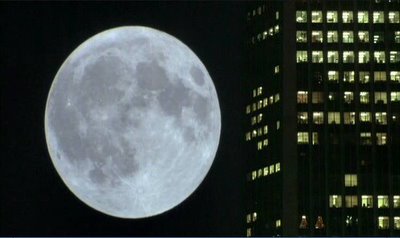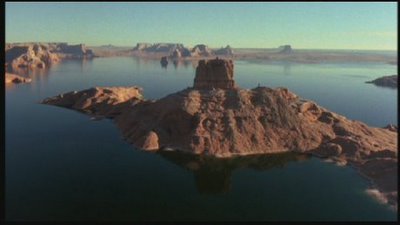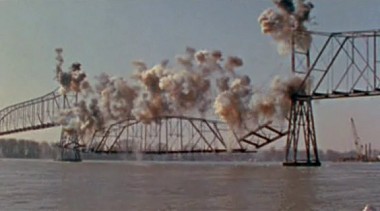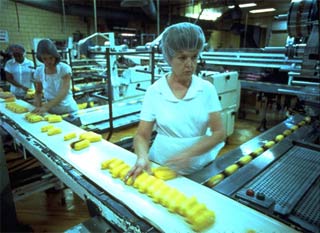
Ah, bliss. Last night, my brother and sister and a few friends and I went to the Queen Elizabeth Theatre to see Koyaanisqatsi (1983), one of my five official favorite films of all time, with live musical accompaniment by the Philip Glass Ensemble.
It had been several years since the last time I saw this film on the big screen, and I had never, ever attended one of Philip Glass’s concerts before, so the whole experience was a real treat.
 I was intrigued, though, to see how the performance by the nine-member ensemble differed from the film’s officially recorded soundtrack, which of course has a fuller, richer sound and is more consistently in sync with the images on screen. And I was also intrigued to see how my instincts compelled me to watch the musicians occasionally, to see how their work had been distributed across their instruments, even as I kept my eyes on the movie screen and its mezmerizing images most of the time.
I was intrigued, though, to see how the performance by the nine-member ensemble differed from the film’s officially recorded soundtrack, which of course has a fuller, richer sound and is more consistently in sync with the images on screen. And I was also intrigued to see how my instincts compelled me to watch the musicians occasionally, to see how their work had been distributed across their instruments, even as I kept my eyes on the movie screen and its mezmerizing images most of the time.
 My brother, who claims he has almost memorized the film, remarked afterwards that he saw images last night that he didn’t remember seeing on his DVD, and I replied that I had had the same experience too — except the images that seemed new to him were not the same images that seemed new to me. Truly, this movie is a different experience every time you watch it.
My brother, who claims he has almost memorized the film, remarked afterwards that he saw images last night that he didn’t remember seeing on his DVD, and I replied that I had had the same experience too — except the images that seemed new to him were not the same images that seemed new to me. Truly, this movie is a different experience every time you watch it.
It was especially good to see the entire film in one sitting again, since for the last few years I have usually watched just a few minutes here or a few minutes there, often while looking for clips to show to friends or to play at speaking engagements.
 And FWIW, one thing that really hit me this time, perhaps more than before, is how in love the movie is with technology, even as it offers up its thoughtful, reflective, self-aware critique of our mechanized, tech-driven society. I mean, it’s impossible for any movie to be truly anti-technology, since film is a profoundly technological artform — especially when the film in question relies as strongly on time-lapse and slow-motion photography as this one does. But beyond that, I see a real poetry in some of the mechanized images — just as I heard a real beauty in some of the electronically reproduced voices coming from the Ensemble.
And FWIW, one thing that really hit me this time, perhaps more than before, is how in love the movie is with technology, even as it offers up its thoughtful, reflective, self-aware critique of our mechanized, tech-driven society. I mean, it’s impossible for any movie to be truly anti-technology, since film is a profoundly technological artform — especially when the film in question relies as strongly on time-lapse and slow-motion photography as this one does. But beyond that, I see a real poetry in some of the mechanized images — just as I heard a real beauty in some of the electronically reproduced voices coming from the Ensemble.
 Can’t say I’d ever want to be the factory worker whose entire job consists of moving Twinkies from one conveyor belt to another, though. I like machines, but they aren’t quite that fascinating!
Can’t say I’d ever want to be the factory worker whose entire job consists of moving Twinkies from one conveyor belt to another, though. I like machines, but they aren’t quite that fascinating!
FWIW, one of my friends also made the interesting remark that, on one level, this film critiques the way that we have all been distanced from one another by our modern mechanistic culture, yet he didn’t get the feeling that the audience at last night’s show was truly “brought together” by the experience; if anything, he thought there was just enough of an art-snob mentality there that kept people separate and distanced from one another. But that, I think, is simply reflective of the way large societies operate, and goes back much earlier than, say, the scientific revolution.
And of course, the film does not exempt its own viewers from whatever critique it makes. Note the shot of a movie audience — in a balcony, just like we last night were in a balcony! — in the montage depicting the craziness of modern society. That’s us!
One final trivia note: The Pruitt-Igoe housing projects that are destroyed at the beginning of the demolished-building sequence were designed by Minoru Yamasaki, the same modernist architect who designed the World Trade Centre. Yamasaki apparently designed his buildings in the belief that better architecture would produce better people, and as I understand it, the squalour of the Pruitt-Igoe neighbourhood and the eventual demolition of those buildings in 1972 were taken as a sign that Yamasaki’s vision had failed, at least in that instance. Make of that what you will.












